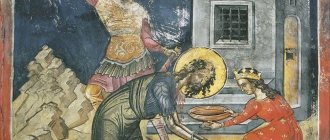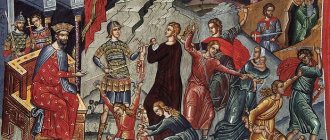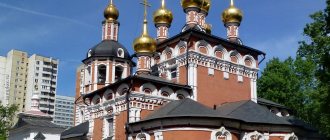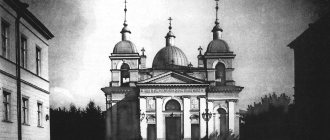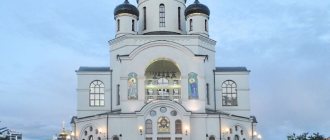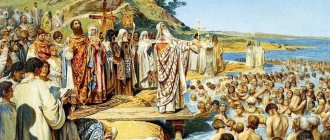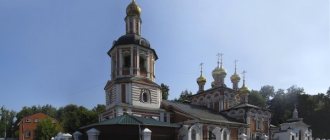For Christians, one of the most important holidays is Christmas - the celebration of the birth of Jesus Christ, the son of God and the Savior of mankind. The celebration of the Nativity of Christ in Russia has undergone many changes, especially during the revolution, but today the traditions of old Rus' are being revived again, young people still go from house to house with carols, Christians observe the Nativity fast, and on Christmas Eve they always put kutya on the table. Most of us know and love these traditions, but where did they come from, and are they very different from the original ones?
Russian traditions
The traditions of this holiday are known to almost every resident of the country, and he himself is loved almost equally by believers and non-believers. After all, even those ignorant of Christian teaching feel some special grace of these days, the closeness of Heaven.
Vasnetsov V.M. Nativity. Murals of the Vladimir Cathedral in Kyiv
When did the Church begin to celebrate the Nativity of the Savior?
The many traditions of the holiday, dating back to antiquity, make us think about its origin, dating back to Apostolic times. Paradoxically, this is not the case.
According to Jewish tradition, celebrating a person’s birthday was not accepted, since life here was understood as suffering. Of course, the Birth of the Savior is a joy for people. But, according to the words of the ap. Paul, “we know no one according to the flesh: even if we knew Christ according to the flesh, now we no longer know him” (2 Cor. 5:16). Therefore, this event in the life of the Lord was not celebrated by ancient Christians. Even about Christmas, only one of the Evangelists speaks in as much detail as possible - Luke, the comrade-in-arms of St. Paul, who preached among the pagans, where the attitude towards birthdays corresponded in general to the Hellenes’ commitment to worldly life and its joys.
Russian liturgist M.M. Skaballanovich writes: “It can be said without exaggeration that the Ancient Church was forced by external influences to establish a holiday in honor of this event.”
Therefore, much earlier than Christmas, the holiday of the Epiphany of the Lord appeared, with which, as a concession to pagan Christians, Christmas was combined. Only from the 4th century. the two celebrations separated, and the Nativity of Christ began to receive theological understanding.
Why is the holiday of the Nativity of Christ so dear and holy for Christians?
The holiday speaks of the great, incomprehensible love of God for man, so that the Creator of the Universe humbles himself and becomes like people in everything. This is a holiday of great hope for the mercy of God, a better future for humanity, in which the Creator Himself believes so much.
Metropolitan Athanasius of Limassol, in a conversation on the holiday of January 6, 2017, says: “The Truth became a Man so that we could love Her. But first She loved us.”
Christmas time.
Speaking about how Russians, Ukrainians and Belarusians celebrate Christmas, it is important to understand that it absorbed many pre-Christian, pagan rituals that corresponded to the ancient beliefs of the Slavic peoples. Thus, folk festivities, called Christmastide, can serve as the best illustration of this. When, back in the first centuries of the arrival of Christianity on Russian soil, Christmas coincided with the ancient pagan ritual of Christmastide, they were not supplanted by Christianity, but were absorbed by it, turning into Christmastide.
They began on the first day after Christmas and lasted until January 19, that is, until the date of Epiphany. On Christmas Day, it was customary for girls to tell fortunes about their “betrothed,” and the methods of fortune telling were very diverse and differed in different areas.
At this time, the famous Christmas fortune-telling is carried out. Every day is full of its own signs, rituals and signs. They pay special attention to dreams; almost all of them are considered prophetic. A dream on the night of Christmas Eve is considered fateful. To remember it, a dream book was placed under the pillow, and a lit candle was left at the head of the bed.
The number of fortune-telling by which you can find out the name or see your betrothed in a dream has no number at all. This includes throwing the left shoe over the threshold, and looking into the mirror, and fortune telling on hair, on rings, on rice, on wax, on coffee grounds, on a chain, etc.
To attract the groom, it was enough to take the damper from the oven, sprinkle bread crumbs on it and feed the rooster. This bird is a symbol of masculinity and a new day, and the grains represent fertility and prosperity (and therefore the groom must be strong, handsome, and rich).
The rooster, especially if it was black, was actively used in other rituals. For example, they poured grain in the center of the room, placed a container of water and a mirror. Whichever object the rooster approaches first is the future groom. If you go to water, you’re a drunkard, if you go to grain, you’re rich, and if you go to a mirror, you’re beautiful.
In general, traditions and fortune telling are very, very diverse and they are different in different regions. Write in the comments what signs, traditions and fortune telling you know, I think all readers will be interested.
What date is this day celebrated in Russia and Europe?
From the middle of the 4th century. a special date for celebration appeared - December 25. It is associated with the Annunciation, which falls on March 25 (April 7, New Art.), Christmas is 9 months away from it, which corresponds to the date of birth of the child. In addition, on December 25, Roman pagans celebrated the Feast of the Sun, the winter solstice. The replacement of a holiday familiar to pagans with a Christian one was more understandable to newly converted believers.
Subsequently, the inaccuracy of the calendar, introduced under Emperor Julius Caesar (Julian), led to the fact that the solstice shifted to December 22 and March 22. Since the time of Easter depends on its date, a new calendar was introduced on February 24, 1582, called the Gregorian calendar, named after Pope Gregory VIII.
Since the Julian and Gregorian calendars have different numbers of leap years, now the difference between them has reached 13 days. A number of Eastern Christian churches have not accepted the Gregorian calendar. It is, however, used as a civil calendar by most countries, including (since the 1920s) Russia, but not by the Russian Church, which comes from the Julian calendar (“old style”).
Thus, there is a discrepancy between the Christian West and the East regarding the dates of Christmas celebration:
- Catholics celebrate it on December 25 AD. Art., except for Greek Catholics, where the date of celebration is January 7;
- the same date is accepted by Protestants;
- the New Julian calendar (since 1923), coinciding with the Gregorian (until 2800) was adopted by the majority of Orthodox Churches, including Constantinople, Greece, Alexandria, Antioch;
- only the Russian Church, as well as the Jerusalem , Polish, Serbian churches, and Mount Athos celebrate Christmas on December 25 according to the Julian calendar, which corresponds to January 7 of the Gregorian (and civil) calendar.
New trends of new centuries
There is a significant difference between how Christmas is celebrated in Rus' today and how it was in the 17th and 18th centuries. And what exactly it is, we will now look at. At the beginning of the 17th century, the Polish national tradition - the Nativity scene - penetrated into Russia. It quickly “transformed” in our country and became an integral part of Christmas in all cities and villages. The idea was that performances were played out using dolls in a special stage box. Initially, they showed how little Jesus was born and how his parents hid him in a cave from Herod. Later, the script could be anything, the main thing is that it imitates some segment of the Savior’s life. Also during these years, those traditions of celebrating Christmas in Rus' that exist to this day were established. Every home decorates a Christmas tree, which is a symbol of celebration. Baked goods in the form of cookies were hung on it, candles were placed, and decorated with fabric, ribbons, and miniatures of the manger in which Jesus was born.
How Orthodox Russians celebrate this day
Orthodox Christians in Russia are now celebrating Christmas:
- attending a church service;
- participation in the sacraments of Confession and Communion;
- decorating your home with a Christmas tree;
- festive meal;
- In addition, in many cities, Orthodox youth are striving to restore the tradition of caroling, walking through the streets singing Christmas carols.
Children's carols
Usually these are short chants glorifying Christmas. For a long time, children and youth sang them when they went around the village to “glorify Christ.” Many of the old carols sound in Ukrainian or Belarusian, since this tradition was most widespread in these places.
Christoslavs are the name given to those who go caroling.
Symbols of Christmas in Russia
Nowadays these symbols include:
- Christmas tree;
- Christmas star;
- nativity scene
When did they start decorating the Christmas tree for this day?
The tradition of putting up a Christmas tree for Christmas appeared no earlier than the beginning of the 18th century. She has German roots. According to legend, in the 8th century. St. Boniface, a Christian missionary, cut down an oak tree revered by German pagans in order to show the powerlessness of false gods. They say that when the tree fell, it broke many others, except for the spruce tree standing nearby. Boniface called her, evergreen, a kind of symbol of unfading life, Paradise, “the tree of the Savior.” Perhaps this is where German Christians developed the custom of putting up a spruce tree at home. Initially, it was not decorated with anything; the custom of hanging fruits and sweets appeared in the 16th century, after the Reformation. And by the 17th century. A tradition arose of decorating the spruce with artificial apples and balls made of glass, paper.
Peter I apparently saw such decorated trees during his trip to Europe (1697), and decided to introduce the tradition he liked. A special decree was adopted on decorating houses with fir trees for Christmas and New Year.
The custom of decorating a tree - a symbol of eternal life - was not alien to Rus', but from ancient times it was not the spruce that was considered such, but the willow, the “Lazarus of the plant world,” the first to awaken after winter. The willow tree was decorated with earthly fruits (fruits, nuts), but not at Christmas, but on Palm Sunday, when this tree “participated” in a special action: “Procession on a donkey,” performed by the patriarch or archbishop on the day of the Lord’s Entry into Jerusalem in Moscow, as well as large dioceses (Novgorod, Tobolsk).
But the idea of decorating the Christmas tree took a long time to take root, with difficulty. Only by the middle of the 19th century. began to install Christmas trees, and only wealthy people. However, already from the beginning of World War 1, they tried to ban the Christmas tree as a German tradition. The second attempt to eradicate the recently born custom occurred already in the Soviet years, when the spruce was already firmly associated with the celebration of Christmas. Only in 1935 the tree was returned to Soviet citizens - but as a New Year's tree.
A little history
Christmas came to our lands along with Christianity. After Saint Vladimir baptized Rus', they began to celebrate it at the state level. In those days, the holiday symbolized the end of the old and the beginning of the year. Therefore, in the period from Christmas to Maslenitsa, annual contracts were concluded between merchants, last year’s affairs were completed and new ones began. In those distant times, almost no one knew about civil calendars; people measured time from one church holiday to another.
Christmas in the 10th–18th centuries
During the times of the Ancient Russian State and the Russian Empire, traditions associated with the Christmas holidays hardly changed. For the peasants, this date was the most convenient. All autumn field work ended, and in winter agriculture froze. Therefore, holiday festivities could last a whole week.
In high society, Christmas was no less popular. Large fairs and folk festivals took place in St. Petersburg and Moscow. Skating rinks and original “amusement parks” were built.
Christmas nativity scene
By the beginning of the 18th century, the Nativity scene came to us from Western Europe - a small theater in which biblical scenes were played out. In some regions this theater was a puppet theater, in others the roles were performed by live actors. The tradition of setting up a nativity scene lasted almost until the middle of the 20th century. During the persecution of religion, it died out and in our times has hardly been revived. And the word “nativity scene” itself has become synonymous with the concept of “amateur theater.”
Arrangement of nativity scenes and children's matinees in churches
Nativity scene in the temple
The prototype of all nativity scenes (as the cave is called in Slavic) is the place where the Savior was born, carefully preserved under the pulpit of the Bethlehem Church of the Nativity. The tradition of creating a kind of model of this cave from various materials comes from the Catholic Saint Francis of Assisi (XIII century).
Nowadays you can order a small nativity scene from a craftsman; in addition, many Orthodox families make such nativity scenes themselves. It could be just a model of a cave reproducing the events of Christmas - the Birth of the Savior, the arrival of the Magi - or a special nativity scene for a theatrical performance about the events of Christmas. Such performances, known since the 17th century, are now becoming the center of Christmas matinees for children.
In addition, it is customary to build large nativity scenes on the territory of many churches: usually this is a cave built from snow on a frame. Hay is laid out here, a manger is set up, where a figurine symbolizing Christ lies. Most often there is a Christmas icon nearby, in front of which you can place a candle. Children love such nativity scenes. But they also help adults feel the events of Christmas.
Where did the gifts under the Christmas tree come from?
We all know very well how Christmas is celebrated in Rus' today. This is a decorated Christmas tree, gifts, the Holy Supper, fortune telling, carols and much more. But where did all this come from? Around the end of the 19th century - the beginning of the 20th, people began to give each other gifts of not only food, but also valuables and souvenirs. In a word, the people themselves gave birth to the tradition of giving gifts to each other. And in order to make it all look more mysterious, they decided to place such gifts under the Christmas tree. Very soon, an analogue of the Western Santa Claus appeared in the country - Grandfather Frost. How was Christmas celebrated in Rus' at the end of the 19th century? About the same as today. Santa Claus gave gifts to children and adults; his image was the basis of the celebration, and almost all men dressed in red fur coats and long white beards to congratulate their own children.
Catholic Christmas symbols
Among the symbols of Christmas specific to Catholicism are, in addition to the nativity scene, the Christmas star, and the fir tree:
- a wreath of spruce, or pine, juniper branches, an important symbol not only of Christmas, but also of Advent: it is placed on the table, decorated with 4 candles according to the number of pre-Christmas Sundays, for each of which a new candle is lit, symbolizing the light of Christ;
- a wreath on the door - a greeting to those coming; it is usually made from coniferous branches;
- from the 19th century The image of “Santa Claus”, which goes back to St., is closely associated with Christmas. Nicholas of Myra, whose celebration falls on December 19; the secularization of the image of the saint is associated with the Protestant traditions of the 19th century: in 1822, the American writer Clement Moore composed a poem about Santa Claus giving gifts to children at Christmas.
Festive meal
Christmas meal includes:
- Christmas Eve meal;
- the actual festive table.
Why is kutya prepared (sochivo)
Before the all-night vigil, Christians usually eat kutya - wheat or other grains (rice, millet) boiled in honey. This Lenten food allows you not only to strengthen your strength before the long night service, but also to spiritually feel the upcoming holiday. I.S. Shmelev in the story “The Summer of the Lord” writes about this :
“Kutya was cooked from wheat, with honey; broth - from prunes, pears, sear... They put it under the icon, on the hay. Why?.. It’s like it’s a gift to Christ. Well... it’s like He’s in the manger, in the manger. It used to be that when you were waiting for a star, you wiped all the windows... The first star, and there was another..."
What dishes are served at the table?
There are no special statutory instructions about the Christmas meal. Usually meat, fish and baked goods are served on the table. According to folk tradition, there were especially many meat dishes on the table, which is associated with the peculiarities of the Russian oven, which made it possible to bake a whole goose, chicken, or pig. Nowadays, housewives proceed from the capabilities and tastes of the family.
What used to be called in the old days the cookies that were prepared for Christmas?
According to folk tradition, cookies called “roes” were considered an obligatory baking item for the holiday, as they were baked in the shape of sheep, cows, and kids. The symbolism of baking is associated with a reminder of the circumstances of the Nativity of the Lord. The cookies were decorated with icing. However, according to folk tradition, it was often used for fortune telling (analogous to “roe” - “fortune cookies” of the Catholic tradition).
The period of paganism in Kievan Rus
Almost 1000 years have passed from the birth of Christ to the date of the official Baptism of Rus'. All this time, our country remained pagan, and, as it is easy to assume, the traditions, temples, rituals and other sacred rituals here were completely different. Nevertheless, from about the 300s, Christian communities began to form in Kyiv, which celebrated Christmas in Ancient Rus' in their own way and according to their own rules. In those years, the main decoration of houses was not a Christmas tree, as it became later, but a certain metal object. It could have any shape and size, as long as it fit under the table. All family members took turns sitting down and putting their feet towards him. It was believed that iron gives a person its strength, strength and endurance. Another paraphernalia is an imitation of Jesus' manger. Houses and streets were always decorated with such miniatures at Christmas. Traditions in Rus' also concerned festive tables. During January 6, people did not eat all day, and sat down to a meal only at dinner. The main dishes were fish, flour products and sweets. Until the official baptism of the entire country, these traditions spread among the people and were firmly rooted in the minds of people.
